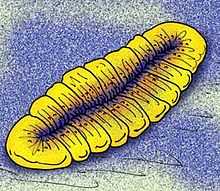Windermeria
From Wikipedia, the free encyclopedia
| Windermeria Temporal range: Ediacaran | |
|---|---|
 | |
| artist's reconstruction | |
| Scientific classification | |
| Kingdom: | Animalia |
| Phylum: | Proarticulata? |
| Class: | Dipleurozoa? |
| Family: | Dickinsoniidae |
| Genus: | Windermeria |
| Species: | W. aitkeni |
| Binomial name | |
| Windermeria aitkeni Narbonne, 1994[1] | |
Windermeria aitkeni is a Precambrian organism from the Blueflower Formation of Sekwi Brook North, in the Northwest Territories of Canada. Only one specimen has been found. Windermeria is a small (16.4 × 7.9 mm) segmented elongated oval fossil, eight nearly equal-sized segments arranged transverse to medial furrow in opposite arrangement.[2] Windermeria superficially resembles a diminutive Dickinsonia and as such is the only possible dickinsoniid known exclusively from outside of Australia and East Europe.[3]
See also
References
- ↑ Narbonne, G. M. (1994). "New Ediacaran fossils from the Mackenzie Mountains, northwestern Canada". Journal of Paleontology 63 (3): 411–416. JSTOR 1306192.
- ↑ Fedonkin M.A., Gehling J.G., Grey K., Narbonne G.M., Vickers-Rich P. (2007). "The Rise of Animals: Evolution and Diversification of the Kingdom Animalia", Johns Hopkins University Press. pp. 292
- ↑ Narbonne G.M. (2007). "Chapter 10. The Canadian Cordillera". In: Fedonkin M.A., Gehling J.G., Grey K., Narbonne G.M., Vickers-Rich P. "The Rise of Animals: Evolution and Diversification of the Kingdom Animalia", Johns Hopkins University Press. pp. 180
External links
This article is issued from Wikipedia. The text is available under the Creative Commons Attribution/Share Alike; additional terms may apply for the media files.